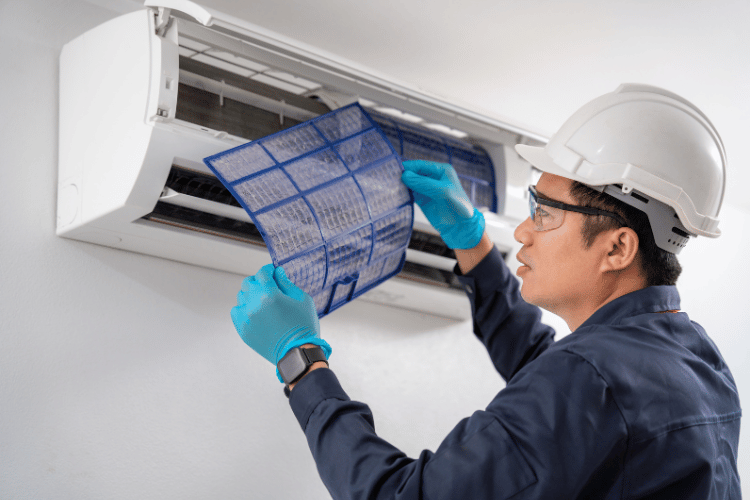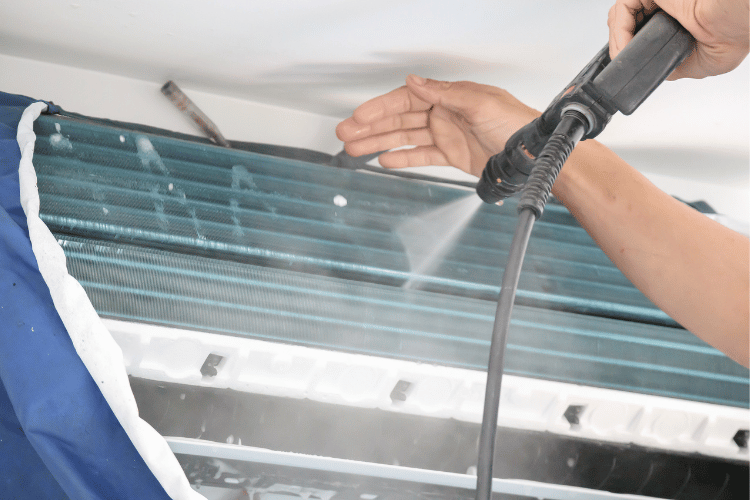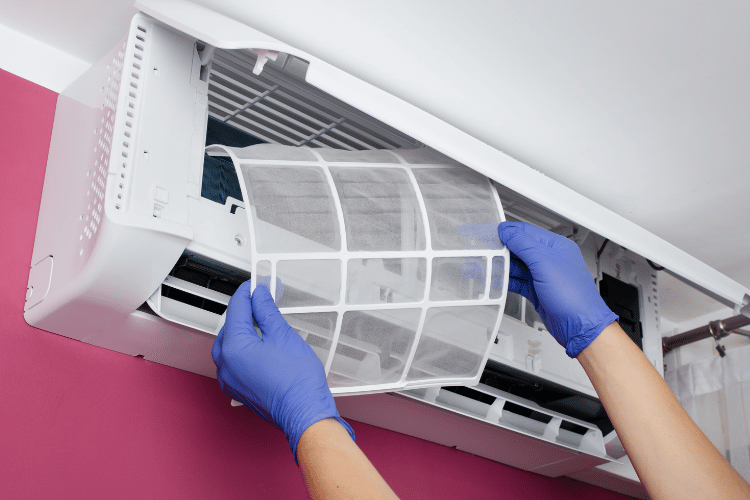
How to Clean your Air Conditioner Filter
In the realm of air conditioning, maintaining a clean filter is paramount. A filter not only ensures efficient operation but also promotes healthier indoor air. By frequently cleaning your filter, you’re investing in the long-term performance and longevity of your air conditioner. So how to clean your air conditioner filter?
Energy efficiency is directly impacted by the state of your filter. A clogged filter can lead to a spike in energy consumption, costing homeowners dearly. A clean filter can reduce electricity bills by 15% compared to a dirty one, according to research.
Engaging in regular maintenance, especially cleaning the filter, is a simple process. Yet, its impact on the overall health of the system and indoor air quality is profound. Let’s delve into understanding your air conditioner filter better and guide you through its cleaning process.
Understanding Your Air Conditioner Filter
The primary function of the air conditioner filter is to trap and reduce indoor pollutants. This ensures the circulated air remains free from dust, pollen, and other contaminants. Moreover, the filter plays a critical role in safeguarding the system from potential damage.
A variety of filters are available in the market. While some are reusable and can be cleaned, others are disposable. On average, reusable filters should ideally be cleaned once a month during peak usage.
Around 60% of homeowners don’t know what kind of filter is in their air conditioners, as per a survey. It’s vital to know whether yours is reusable or disposable to adopt the correct maintenance approach.
Research suggests that a clean filter can increase the efficiency of your air conditioner by up to 10%. Thus, not only do you save on electricity costs, but you also ensure a longer life for your equipment.
Signs That Your Air Conditioner Filter Needs Cleaning
A dirty air conditioner filter can cause the cooling system to work less effectively. If you find that your room takes longer than usual to reach the desired temperature, or if the airflow emanating from the vents feels weak or less cool, it’s a clear sign that the filter might be obstructed. An obstructed filter forces the system to work harder, which not only consumes more energy but could also lead to premature wear and tear of the system.
Another audible hint is a change in the unit’s operation sounds. If you hear unfamiliar noises, like whirring or humming that wasn’t present before, or if the system seems to be running continuously without cycling off, these could be symptoms of a filter that needs attention. A clogged filter can cause the system’s motor to overwork, and these altered sounds might be a result of that additional strain. A dirty filter can make your electricity bills go up unexpectedly by making your appliances run for longer.
A direct visual inspection can also be quite telling. If you can see a thick layer of dust, dirt, or any other debris settled on the filter’s surface, it’s a definitive sign that a cleaning is overdue. Over time, as contaminants accumulate, they restrict the airflow, diminishing the system’s efficiency and potentially circulating unclean air inside your living space.
Lastly, if you or any of your family members start experiencing increased allergic reactions, or if there’s a sudden onset of unexplained respiratory issues, it might be due to the deteriorated air quality from a clogged filter. Dirty filters can let allergens like pollen, pet dander, and dust mites circulate in the air indoors, causing health problems.
Step-by-Step Guide: How to Clean your Air Conditioner Filter
1. Safety First:
Before diving into the cleaning process, ensuring safety is paramount. Always disconnect the air conditioner from the power source to prevent any electrical mishaps. This simple step guarantees that the system is inert, allowing you to work without any unexpected surprises.
2. Accessing the Filter:
Typically, the filter is located behind the air conditioner’s front panel or grille. Gently open or snap off the panel. Most modern air conditioners are designed for easy filter access, but if you encounter any challenges, consult the user manual for your specific model.
3. Examining the Filter:
Once the filter is visible, take a moment to inspect it. Gray and dusty is fine, but lots of dirt or mold means it’s time to clean. If the filter appears damaged or exceedingly worn out, consider replacing it.
4. Dusting Off:
Before washing, it’s advisable to remove loose dust and debris. Use a soft brush or a handheld vacuum cleaner to gently clean the filter’s surface. This step ensures that the subsequent washing process is more effective and less messy.
5. Preparing the Cleaning Solution:
Fill a basin with lukewarm water and add a few drops of mild dish detergent. The solution should be sudsy but not overly so. Avoid using harsh chemicals or strong detergents as they might damage the filter or leave a residue that can circulate in your living space.
6. Gentle Washing:
Submerge the filter into the soapy solution. Using your hands or a soft brush, gently scrub the filter to dislodge dirt and debris. Remember, the key is to be gentle; excessive force can damage the delicate fibers of the filter.
7. Rinsing:
After cleaning, rinse the filter thoroughly under running water to remove any soap residues. It is crucial to ensure that there is no detergent residue on the filter. This residue can negatively affect the air quality when the unit is in operation.

8. Drying the Filter:
Once cleaned, allow the filter to air dry naturally. Place it in a shaded area with good ventilation. Avoid direct sunlight, as it may warp the filter. Ensure the filter is completely dry before reinserting it to prevent mold growth or reduced efficiency.
9. Reinserting the Filter:
Once dry, slide the filter back into its slot, ensuring it fits snugly. Misalignments can lead to inefficiencies as unfiltered air might find its way into the system. Secure the front panel or grille back into place.

10. Powering Up and Testing:
After the filter is securely in place, reconnect the power. Turn on the air conditioner and check for smooth operation. The airflow should feel stronger, and the system should operate more quietly. Over the next few days, you’ll likely notice improved cooling efficiency and better air quality in your home.
How to clean your air conditioner filter: Drying and Reinserting the Filter
Proper drying is a pivotal step in the filter cleaning process. After washing the filter, lay it flat in a shaded and well-ventilated area for quick and even drying. Direct exposure to sunlight can potentially cause warping or degrade the material of the filter, thereby compromising its efficiency.
Be patient. Hurrying and putting in a wet filter can cause issues like mold, bad smells, or a less effective air conditioner.
Ensuring the filter is completely dry before reinsertion is crucial. Moisture can breed bacteria and mold, which can then spread into your home and cause health problems. Advisable to check both sides of the filter and even hold it up against light to ensure no damp patches remain.
Your air conditioner is crucial for maintaining clean air inside your home. A clean filter is an essential component of this process.
When it comes to reinserting the filter, precision matters. Slide the filter back into its designated slot, ensuring a snug fit. A misaligned filter can allow unfiltered air to bypass, negating the purpose of having a filter in the first place.
Once seated correctly, close the front panel securely. A quick run post-reinsertion will confirm if the filter sits perfectly, allowing you to breathe in cleaner, fresher air while also maintaining the efficiency of your cooling unit.
When to Consider Replacing Your Filter
Air conditioner filters are designed for prolonged use, but they aren’t invincible. Over time, they succumb to wear, and their efficiency begins to wane. One primary indication that a filter needs replacement is if, after multiple cleanings, the air flow or cooling efficiency doesn’t improve. Consistent reduced performance, despite proper maintenance, often signals that the filter material has degraded and can no longer function optimally.
Another clear sign is the visible condition of the filter. If you notice any physical damages such as tears, rips, or persistent clogs that don’t clear up even after cleaning, it’s a stark indication that the filter has reached its end. Damaged filters not only reduce the efficiency of the air conditioner but can also allow harmful particles to infiltrate the circulated air, compromising indoor air quality.
On average, a reusable filter can be washed and reused about 12-15 times before its efficiency drops considerably. Hence, tracking the number of cleanings can provide a ballpark estimate on when to replace it. Furthermore, environmental factors play a role. Homes located in dusty areas or with higher pollutant levels might require more frequent filter replacements than those in cleaner environments.
Lastly, Green Air is dedicated to providing high-quality air conditioning filters that are durable and efficient. We suggest homeowners check their filters every year, especially before summer, to see if they are still good. This ensures not just optimal cooling but also guarantees that the air you breathe remains pure and uncontaminated.
Conclusion
To sum up we have explained how to clean your air conditioner filter:
Regular maintenance, especially cleaning the air conditioner filter, is an investment in efficiency and health. A small effort can lead to considerable energy savings, enhanced system longevity, and improved indoor air quality.
Green Air’s dedication to quality and customer service means homeowners can enjoy the benefits of efficient air conditioning. By following this guide, you’re not only ensuring optimal performance but also significantly reducing your carbon footprint.
With the summer months approaching, ensure your air conditioner is in top shape. Clean filters promise a cooler, healthier environment, elevating the comfort levels of your abode.
